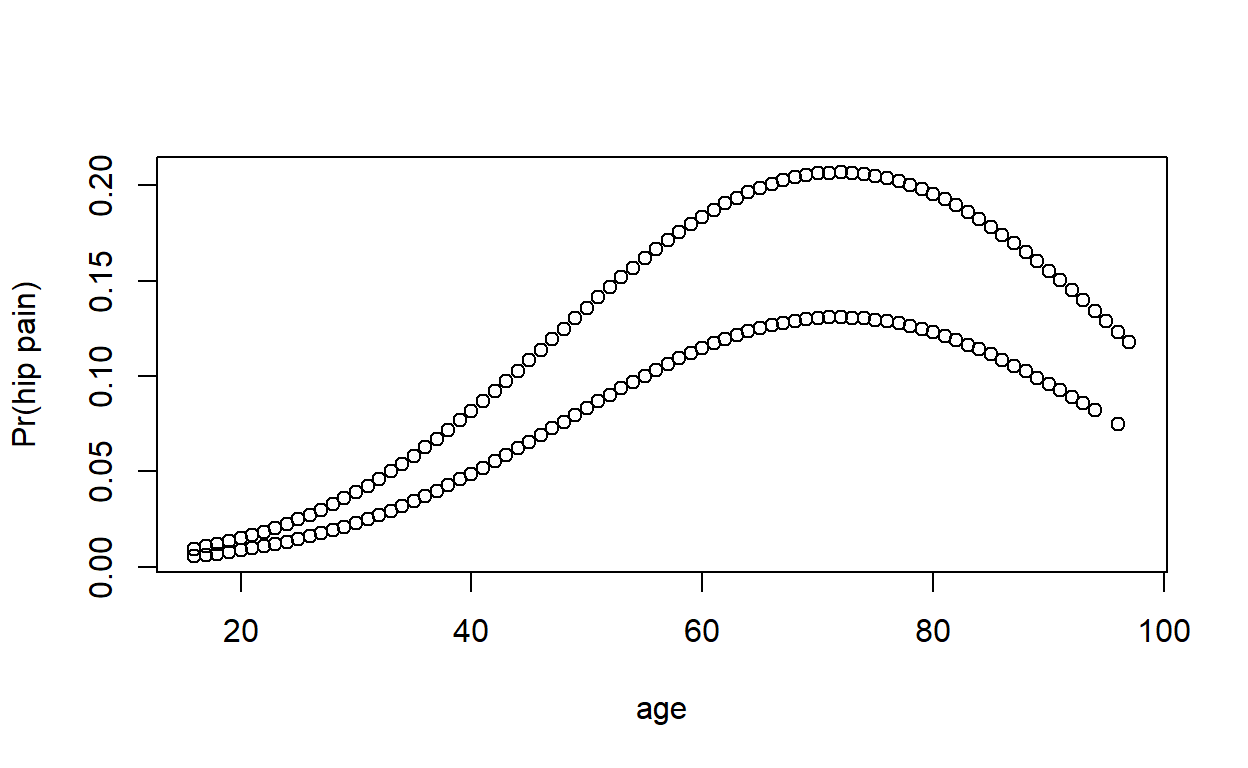This worksheet is based on the seventh lecture of the Statistical Modelling in Stata course, created by Dr Mark Lunt and offered by the Centre for Epidemiology Versus Arthritis at the University of Manchester. The original Stata exercises and solutions are here translated into their R equivalents.
Refer to the original slides and Stata worksheets here.
Cross-tabulation and logistic regression
Use the dataset epicourse.csv.
epicourse <- read.csv('epicourse.csv')Produce a table of hip pain by gender using the table() function. What is the prevalance of hip pain in men and in women?
Generate a table of counts using
And you can convert this into a table of proportions within each sex (2nd margin) using:
prop.table(hip_tab, margin = 2) sex
hip_p F M
no 0.84770485 0.90155678
yes 0.15229515 0.09844322In R 4.0.0, you can also use the new proportions() function.
proportions(hip_tab, margin = 2) sex
hip_p F M
no 0.84770485 0.90155678
yes 0.15229515 0.09844322Perform a chi-squared test to test the hypothesis that there is a different prevalence of hip pain in men versus women.
chisq.test(hip_tab)
Pearson's Chi-squared test with Yates' continuity correction
data: hip_tab
X-squared = 29.158, df = 1, p-value = 6.672e-08Obtain the odds ratio for being female compared to being male. What is the confidence interval for this odds ratio?
Recall the formula for an odds ratio is \[\text{OR} = \frac{D_E / H_E}{D_N / H_N},\] where \(D\) denotes ‘diseased’, \(H\) is ‘healthy’, \(E\) is ‘exposed’ (i.e. female) and \(N\) is ‘not exposed’ (i.e. male).
odds_ratio <- (hip_tab['yes', 'F'] / hip_tab['no', 'F']) /
(hip_tab['yes', 'M'] / hip_tab['no', 'M'])
odds_ratio[1] 1.645314And the Wald 95% confidence interval for the odds ratio given by \[\exp \left\{ \log \text{OR}~\pm~z_{\alpha/2} \times \sqrt{\tfrac1{D_E} + \tfrac1{D_N} +\tfrac1{H_E} + \tfrac1{H_N}} \right\},\] where \(z_{\alpha/2}\) is the critical value of the standard normal distribution at the \(\alpha\) significance level. In R, this interval can be computed as follows:
How does the odds ratio compare to the relative risk?
The relative risk is \[\text{RR} = \frac{D_E / N_E}{D_N / N_N},\] where \(N_E = D_E + H_E\) and \(N_N = D_N + H_N\) are the respective total number of exposed (female) and not-exposed (male) people in the sample. In R, it is
rel_risk <- hip_tab['yes', 'F'] / colSums(hip_tab)['F'] /
(hip_tab['yes', 'M'] / colSums(hip_tab)['M'])
rel_risk F
1.547035 Does the confidence interval for the odds ratio suggest that hip pain is more common in one of the sexes?
I can’t see any point in computing a relative risk confidence interval here, even if the Stata command cs reports it.
Now fit a logistic regression model to calculate the odds ratio for being female, using the glm function. How does the result compare to that computed above?
Note. The glm function needs responses to be between 0 and 1, so it won’t work with a character vector of ‘yes’ and ‘no’.
An easy solution is to replace hip_p with TRUE and FALSE (which in R is the same as 1 and 0).
Either do this before fitting the model, or inline:
Call:
glm(formula = hip_p == "yes" ~ sex, family = binomial("logit"),
data = epicourse)
Deviance Residuals:
Min 1Q Median 3Q Max
-0.5748 -0.5748 -0.4553 -0.4553 2.1533
Coefficients:
Estimate Std. Error z value Pr(>|z|)
(Intercept) -1.71671 0.05765 -29.781 < 2e-16 ***
sexM -0.49793 0.09209 -5.407 6.41e-08 ***
---
Signif. codes: 0 '***' 0.001 '**' 0.01 '*' 0.05 '.' 0.1 ' ' 1
(Dispersion parameter for binomial family taken to be 1)
Null deviance: 3424.1 on 4514 degrees of freedom
Residual deviance: 3394.1 on 4513 degrees of freedom
AIC: 3398.1
Number of Fisher Scoring iterations: 4In this model, the intercept parameter estimate represents the log-odds of having hip pain, for women (taken to be the baseline).
The sexM is the additive effect (to these log-odds) from being a man.
Thus the odds ratio is simply the exponential of the negation of this second parameter:
How does the confidence interval compare to that calculated above?
Introducing continuous variables
Age may well affect the prevalence of hip pain, as well as gender. To test this, create an agegroup variable with the following code:
Tabulate hip pain against age group with the table() function. Is there evidence that the prevalence of hip pain increases with age?
agegroup
hip_p (0,30] (30,40] (40,50] (50,60] (60,70] (70,80] (80,90] (90,100]
no 423 353 534 484 792 965 362 32
yes 10 13 55 86 158 176 63 9chisq.test(age_tab)
Pearson's Chi-squared test
data: age_tab
X-squared = 105.02, df = 7, p-value < 2.2e-16Add age to the logistic regression model for hip pain. Is age a significant predictor of hip pain?
You can rewrite the model from scratch with glm(), or use this convenient shorthand:
Call:
glm(formula = hip_p == "yes" ~ sex + age, family = binomial("logit"),
data = epicourse)
Deviance Residuals:
Min 1Q Median 3Q Max
-0.8441 -0.5684 -0.4801 -0.3639 2.6272
Coefficients:
Estimate Std. Error z value Pr(>|z|)
(Intercept) -3.326800 0.192175 -17.311 < 2e-16 ***
sexM -0.530815 0.093057 -5.704 1.17e-08 ***
age 0.025813 0.002808 9.193 < 2e-16 ***
---
Signif. codes: 0 '***' 0.001 '**' 0.01 '*' 0.05 '.' 0.1 ' ' 1
(Dispersion parameter for binomial family taken to be 1)
Null deviance: 3424.1 on 4514 degrees of freedom
Residual deviance: 3298.9 on 4512 degrees of freedom
AIC: 3304.9
Number of Fisher Scoring iterations: 5How do the odds of having hip pain change when age increases by one year?
It is a logistic model, so the parameter estimate represents the increase in log-odds for one year increase in age.
Fit an appropriate model to test whether the effect of age differs between men and women.
Call:
glm(formula = hip_p == "yes" ~ age * sex, family = binomial,
data = epicourse)
Deviance Residuals:
Min 1Q Median 3Q Max
-0.8812 -0.5540 -0.4730 -0.3643 2.5245
Coefficients:
Estimate Std. Error z value Pr(>|z|)
(Intercept) -3.548531 0.244116 -14.536 < 2e-16 ***
age 0.029195 0.003598 8.115 4.85e-16 ***
sexM 0.060534 0.387861 0.156 0.876
age:sexM -0.008986 0.005742 -1.565 0.118
---
Signif. codes: 0 '***' 0.001 '**' 0.01 '*' 0.05 '.' 0.1 ' ' 1
(Dispersion parameter for binomial family taken to be 1)
Null deviance: 3424.1 on 4514 degrees of freedom
Residual deviance: 3296.5 on 4511 degrees of freedom
AIC: 3304.5
Number of Fisher Scoring iterations: 5Rather than fitting age as a continuous variable, it is possible to fit it as a categorical variable.
It might naively be thought that the only justification for fitting such a model would be if the underlying continuous data were not available. But it can also be useful for reporting purposes if the categories are meaningful clinically. Or if the log odds of pain do not increase linearly with age (spoiler alert: that is the case here). Admittedly, in that case, doing something clever with the continuous predictor might be at least as good as using categories, but lets see what happens with the categories anyway.
model4 <- glm(hip_p == 'yes' ~ sex + agegroup , data = epicourse, family = binomial)
summary(model4)
Call:
glm(formula = hip_p == "yes" ~ sex + agegroup, family = binomial,
data = epicourse)
Deviance Residuals:
Min 1Q Median 3Q Max
-0.7617 -0.6269 -0.4944 -0.2400 2.8611
Coefficients:
Estimate Std. Error z value Pr(>|z|)
(Intercept) -3.53283 0.32165 -10.983 < 2e-16 ***
sexM -0.54337 0.09336 -5.820 5.89e-09 ***
agegroup(30,40] 0.44742 0.42715 1.047 0.295
agegroup(40,50] 1.47949 0.35027 4.224 2.40e-05 ***
agegroup(50,60] 2.03600 0.34110 5.969 2.39e-09 ***
agegroup(60,70] 2.17367 0.33204 6.546 5.90e-11 ***
agegroup(70,80] 2.08573 0.33071 6.307 2.85e-10 ***
agegroup(80,90] 2.00556 0.34831 5.758 8.51e-09 ***
agegroup(90,100] 2.44389 0.49639 4.923 8.51e-07 ***
---
Signif. codes: 0 '***' 0.001 '**' 0.01 '*' 0.05 '.' 0.1 ' ' 1
(Dispersion parameter for binomial family taken to be 1)
Null deviance: 3424.1 on 4514 degrees of freedom
Residual deviance: 3257.9 on 4506 degrees of freedom
AIC: 3275.9
Number of Fisher Scoring iterations: 6What are the odds of having hip pain for a man aged 55, compared to a man aged 20?
man_55_20c <- predict(model4, newdata = list(sex = c('M', 'M'),
agegroup = c('(50,60]', '(0,30]')))
exp(man_55_20c[1] - man_55_20c[2]) 1
7.659881 Goodness of fit
Look back at the logistic regression model that was linear in age.
(There is no need to refit the model if it is still stored as a variable,
e.g. model2 in our case)
Perform a Hosmer–Lemeshow test. Is the model adequate, according to this test?
This test is not avalable in base R, so we need to install one of the (many) packages that provides it: we’ll use glmtoolbox.
if(require(glmtoolbox)==FALSE) {
install.packages("glmtoolbox")
library(glmtoolbox)
}
hltest(model2)
The Hosmer-Lemeshow goodness-of-fit test
Group Size Observed Expected
1 451 8 20.39258
2 449 29 29.85560
3 461 47 38.12533
4 452 52 46.09621
5 477 60 54.24040
6 433 62 54.87545
7 452 59 64.16206
8 453 78 75.08576
9 477 93 91.43995
10 410 82 95.72665
Statistic = 15.97762
degrees of freedom = 8
p-value = 0.042702 Obtain the area under the ROC curve.
I also had to look this up.
There are various R packages for computing and plotting ROC curves. We will use pROC, since it makes producing confidence intervals easy, and they are vital to any statistical inference.
if(require(pROC)==FALSE ) {
install.packages("pROC")
library(pROC)
}
pROC_obj <- roc(model2$y, model2$fitted.values,ci=TRUE, plot=TRUE,auc.polygon=TRUE,print.auc=TRUE, show.thres=TRUE)
sens.ci <- ci.se(pROC_obj)
plot(sens.ci, type="shape", col="lightblue")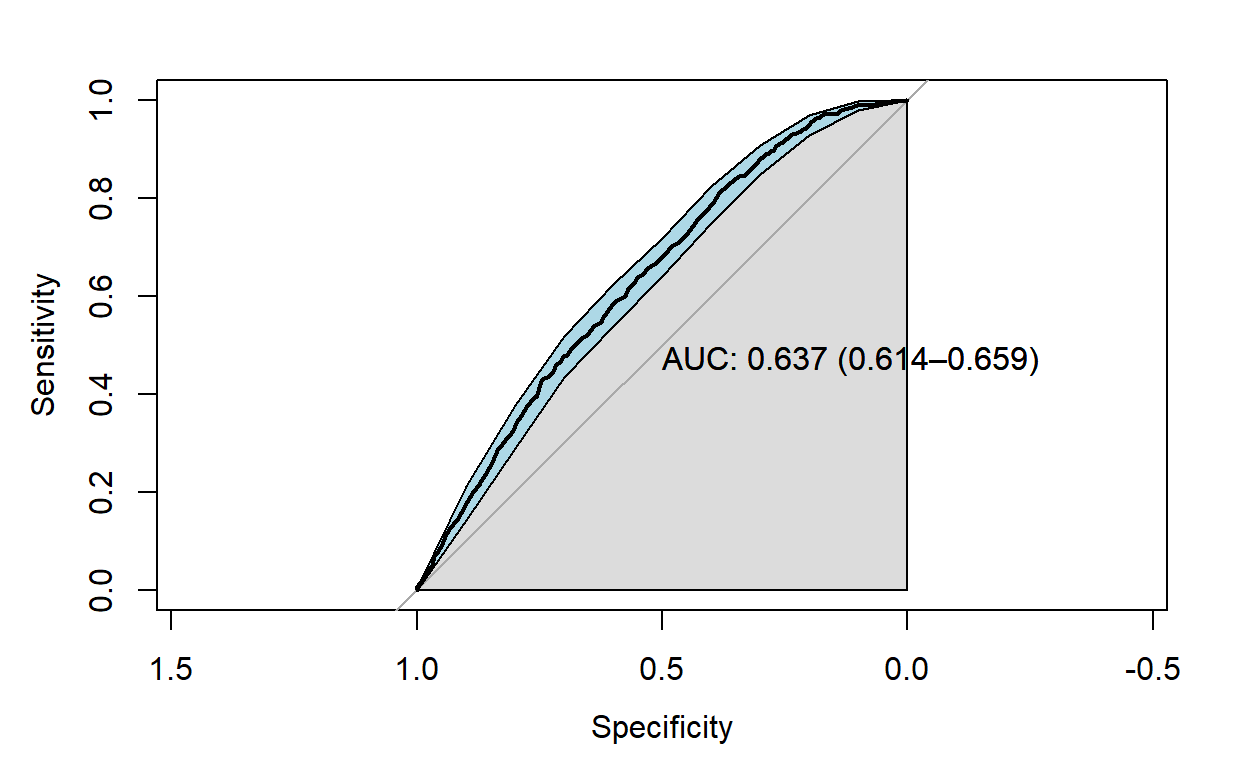
Now recall the logistic regression model that used age as a categorical variable. Is this model adequate according to the Hosmer-Lemeshow test
hltest(model4)
The Hosmer-Lemeshow goodness-of-fit test
Group Size Observed Expected
1 364 7 7.615801
2 435 16 15.384199
3 463 38 40.337537
4 319 34 36.275270
5 269 37 30.947529
6 588 66 70.682056
7 485 66 62.964352
8 548 96 98.892386
9 553 110 105.317944
10 491 100 101.582924
Statistic = 2.63554
degrees of freedom = 8
p-value = 0.95511 What is the area under the ROC curve for this model?
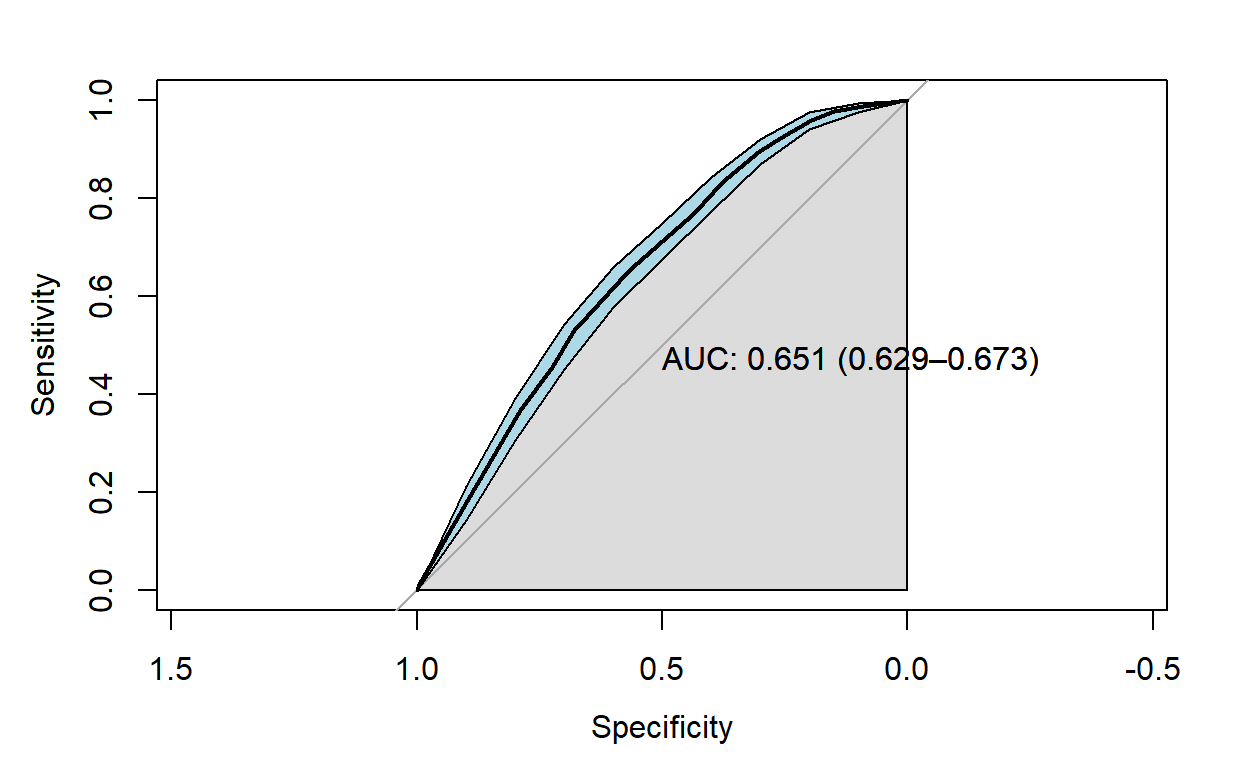
Create an age2 term and add this to the model with age as a continuous variable. Does adding this quadratic term improve the fit of the model?
Obviously it will improve the fit, but whether it is worth the added complexity is another question.
Call:
glm(formula = hip_p == "yes" ~ sex + age + I(age^2), family = binomial("logit"),
data = epicourse)
Deviance Residuals:
Min 1Q Median 3Q Max
-0.6809 -0.5912 -0.5124 -0.2951 3.1901
Coefficients:
Estimate Std. Error z value Pr(>|z|)
(Intercept) -6.8154736 0.6747805 -10.100 < 2e-16 ***
sexM -0.5499348 0.0932640 -5.897 3.71e-09 ***
age 0.1523200 0.0224885 6.773 1.26e-11 ***
I(age^2) -0.0010601 0.0001827 -5.802 6.56e-09 ***
---
Signif. codes: 0 '***' 0.001 '**' 0.01 '*' 0.05 '.' 0.1 ' ' 1
(Dispersion parameter for binomial family taken to be 1)
Null deviance: 3424.1 on 4514 degrees of freedom
Residual deviance: 3258.0 on 4511 degrees of freedom
AIC: 3266
Number of Fisher Scoring iterations: 6hltest(modelq)
The Hosmer-Lemeshow goodness-of-fit test
Group Size Observed Expected
1 445 8 7.817101
2 440 18 23.017377
3 453 42 39.813627
4 465 55 53.071191
5 464 63 58.388841
6 472 59 61.183630
7 455 66 65.503783
8 435 83 80.525915
9 447 93 90.168478
10 439 83 90.510057
Statistic = 2.86936
degrees of freedom = 8
p-value = 0.94229 Obtain the area under the ROC curve for this model. How does it compare for the previous models you considered?
Using the same procedure as above, we obtain the AUC:
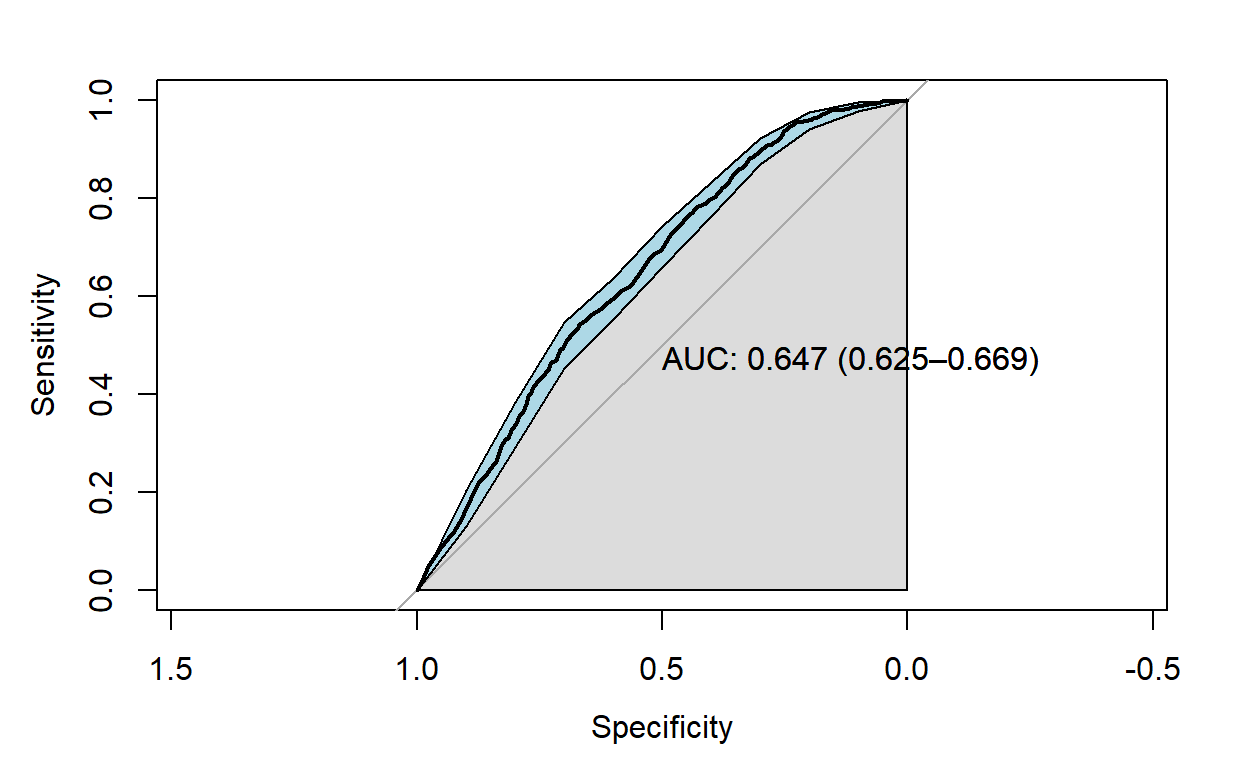
Diagnostics
It is not easy to replicate Stata’s diagnostics in R
Produce a scatter plot of \(\Delta\hat\beta_i\) against fitted values for the previous regression model. Is there any evidence of an influential point?
Pregibon’s \(\Delta\hat\beta_i\) statistic, according to the Stata documentation, has the formula \[\Delta\hat\beta_i = \frac{r_j^2 h_j}{(1 - h_j)^2},\] where \(r_j\) is the Pearson residual for the \(j^\text{th}\) observation and \(h_j\) is the \(j^\text{th}\) diagonal element of the hat matrix.
Unfortunately, calculating it is not straightforward, as R and stata
differ about what a Pearson residual is and what the hat matrix
is. And I could not find a package that did it. Don’t worry if you
don’t understand what the function pregibon is doing below: I’m not
sure I do (``I’’ here being ML, not DS :-)). However, it does
duplicate the statistics produced by Stata.
pregibon <- function(model) {
# This is very similar to Cook's distance
Y <- tapply(model$y, list(model$model$sex, model$model$age), sum)
M <- tapply(model$y, list(model$model$sex, model$model$age), length)
vY <- diag(Y[as.character(model$model$sex), as.character(model$model$age)])
vM <- diag(M[as.character(model$model$sex), as.character(model$model$age)])
pr <- (vY - vM*model$fitted.values)/sqrt(vM*model$fitted.values*(1-model$fitted.values))
V <- vcov(model)
X <- cbind(rep(1, 4515), model$model$sex=="M", model$model$age, model$model$age*model$model$age)
uhat <- diag(X %*% V %*% t(X))
hat <- uhat*vM*model$fitted.values*(1-model$fitted.values)
db <- (pr^2*hat)/(1-hat)^2
}
plot(fitted(modelq), pregibon(modelq), type = 'h')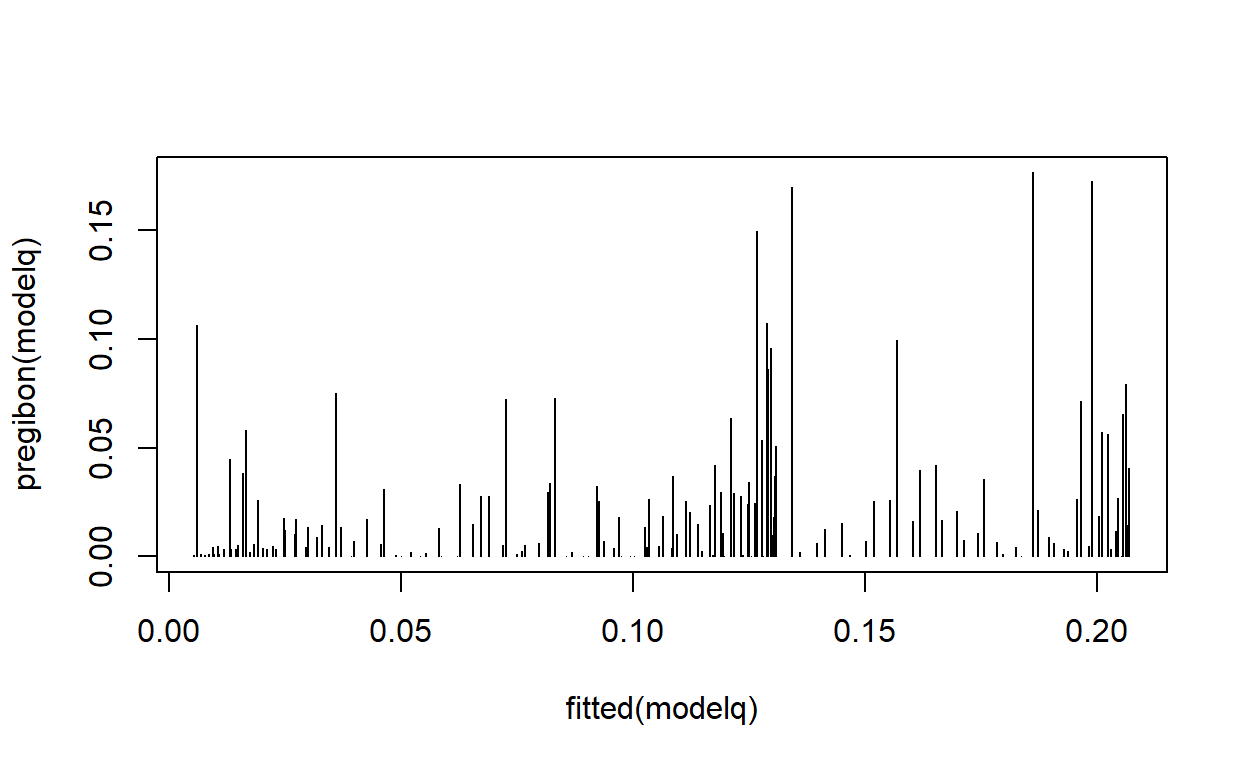
# You could compare this to Cook's distance using the command below, but Cook's distance does not have an
# interpretation for logistic regression, only linear regression
# plot(modelq, which = 4)Obtain the deviance residuals and plot them against the fitted values. Is there evidence of a poor fit for any particular range of predicted values?
Deviance residuals are accessible via residuals(model, type = 'deviance').
plot(fitted(modelq), residuals(modelq, type = 'deviance'),
xlab = 'Fitted values', ylab = 'Deviance residuals')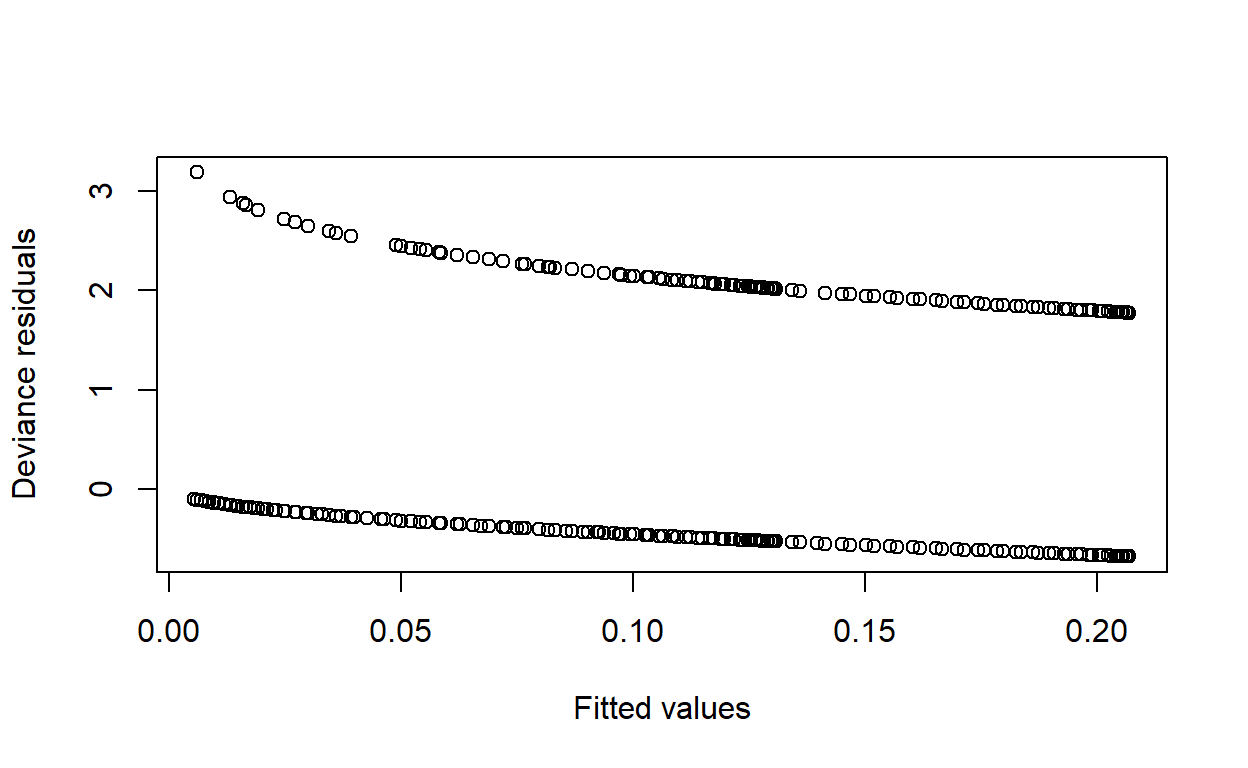
Plot fitted values against age. Why are there two curves?
Compare logistic regression model predictions to a non-parametric smoothed curve.
You can use loess(), or geom_smooth() in ggplot2. If you are having trouble, try
adjusting the smoothing parameter (span), and make sure the variables are in a
numeric/binary format, as loess() doesn’t really like factors.
if(require(ggplot2)==FALSE) {
install.packages(ggplot2)
library(ggplot2)
}
ggplot(epicourse) +
aes(age, as.numeric(hip_p) - 1) +
geom_point(aes(y = fitted(modelq))) +
geom_smooth(aes(colour = sex), method = 'loess', se = F, span = .75) +
ylab('Pr(hip pain)')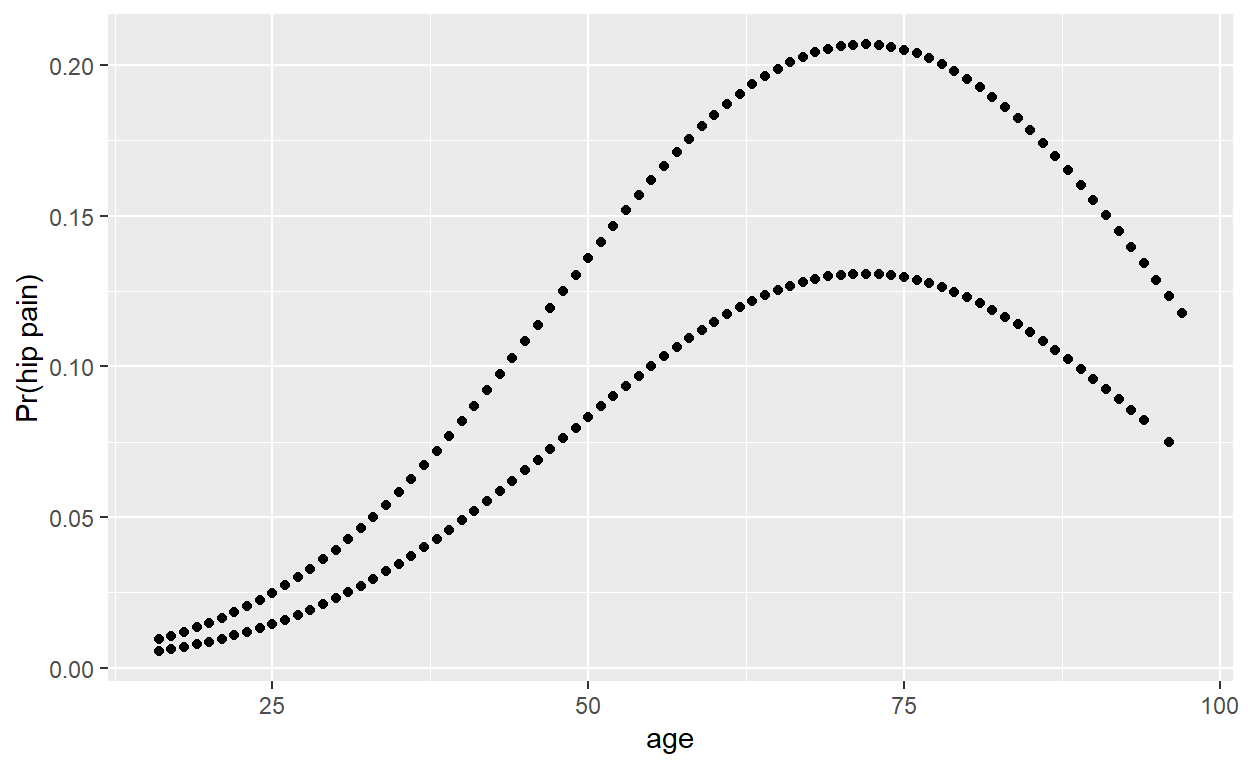
nonpar <- loess(data = transform(epicourse,
pain = as.numeric(hip_p == 'yes'),
male = as.numeric(sex == 'M')),
pain ~ age * male, span = .75)
plot(epicourse$age, fitted(modelq), xlab = 'Age', ylab = 'Pr(hip pain)')
lines(1:100, predict(nonpar, newdata = data.frame(age = 1:100, male = T)), col = 'steelblue')
lines(1:100, predict(nonpar, newdata = data.frame(age = 1:100, male = F)), col = 'tomato2')
legend('topleft', lty = 1, col = c('steelblue', 'tomato2'), legend = c('M', 'F'))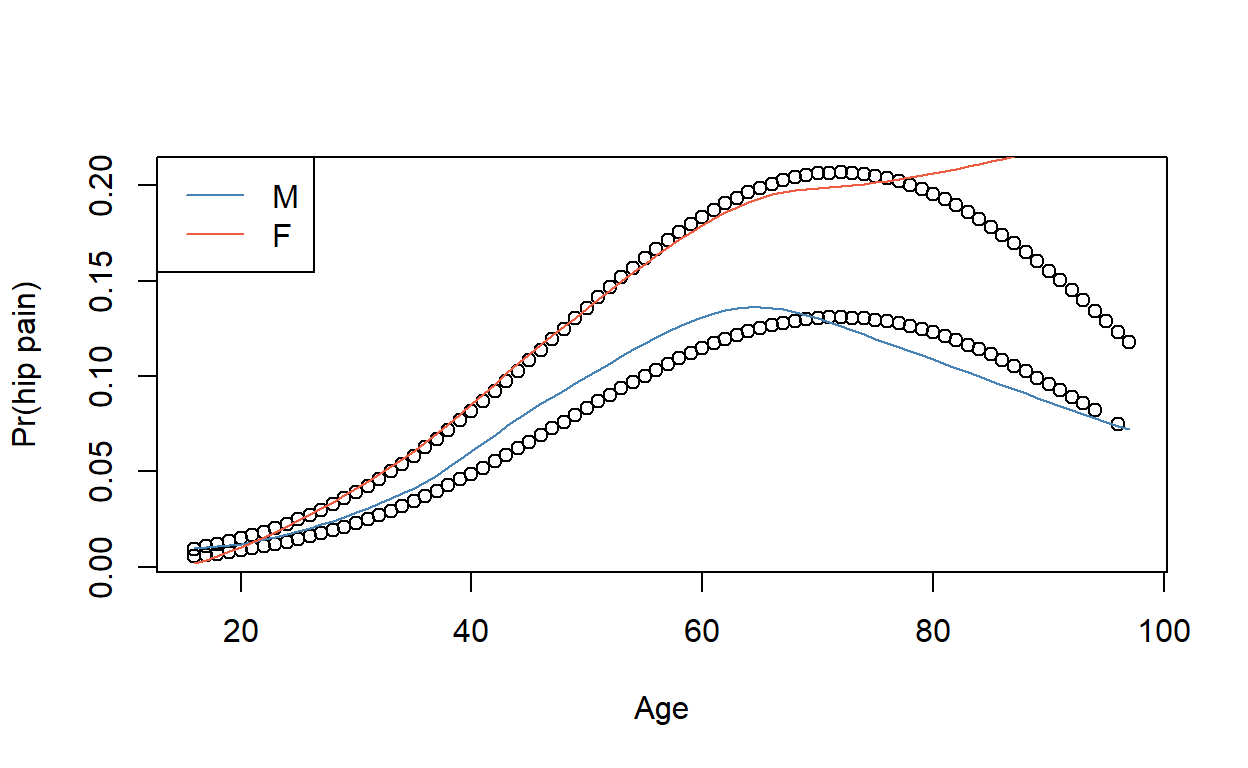
The CHD data
This section of the practical gives you the opportunity to work through the CHD example that was used in the notes.
chd <- read.csv('chd.csv')The following commands will reproduce Figure 1.2 using base R:
chd_means <- aggregate(cbind(age, chd) ~ agegrp, mean, data = chd)
plot(chd ~ age, data = chd_means,
xlab = 'Mean age', ylab = 'Proportion of subjects with CHD',
main = 'Scatter plot of proportion of CHD against mean age')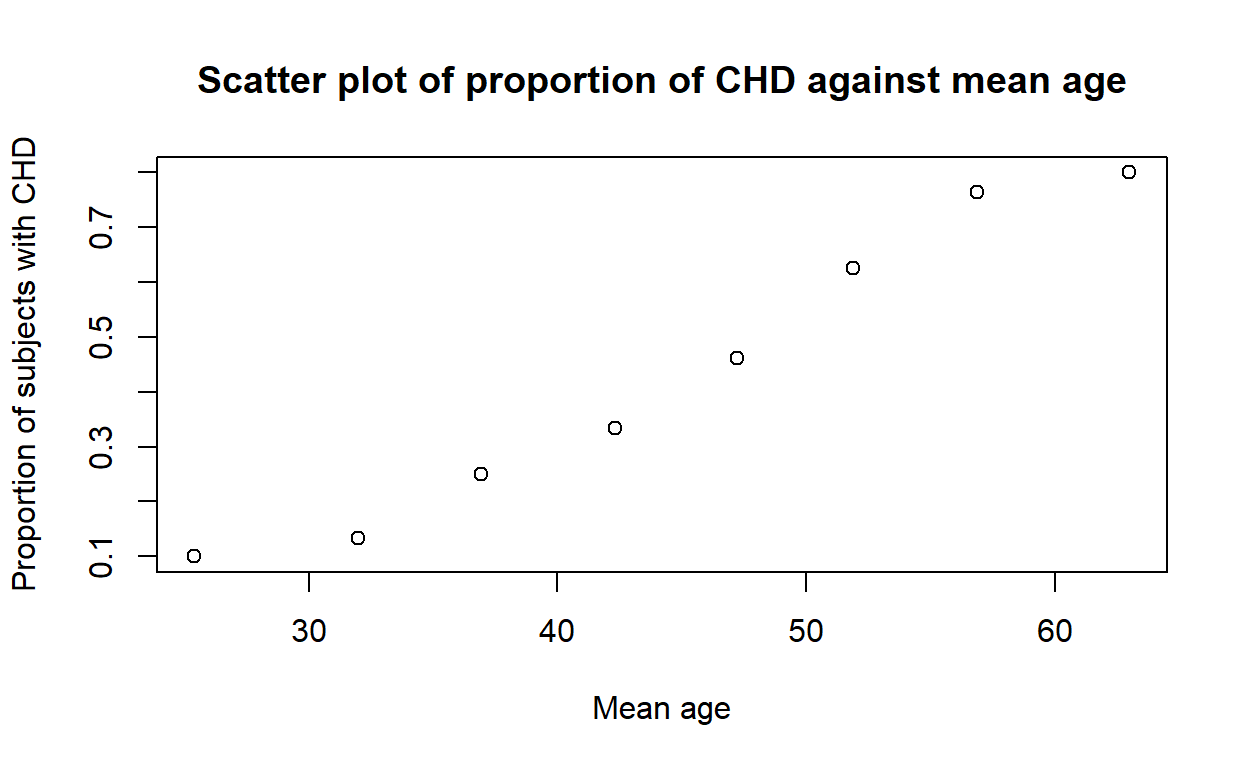
It can also be done in dplyr and ggplot2:
if (require(dplyr)==FALSE) {
install.packages(dplyr)
library(dplyr)
}
chd %>%
group_by(agegrp) %>%
summarise(agemean = mean(age),
chdprop = mean(chd)) %>%
ggplot() + aes(agemean, chdprop) +
geom_point() +
labs(x = 'Mean age', y = 'Proportion of subjects with CHD',
main = 'Scatter plot of proportion of CHD against mean age') 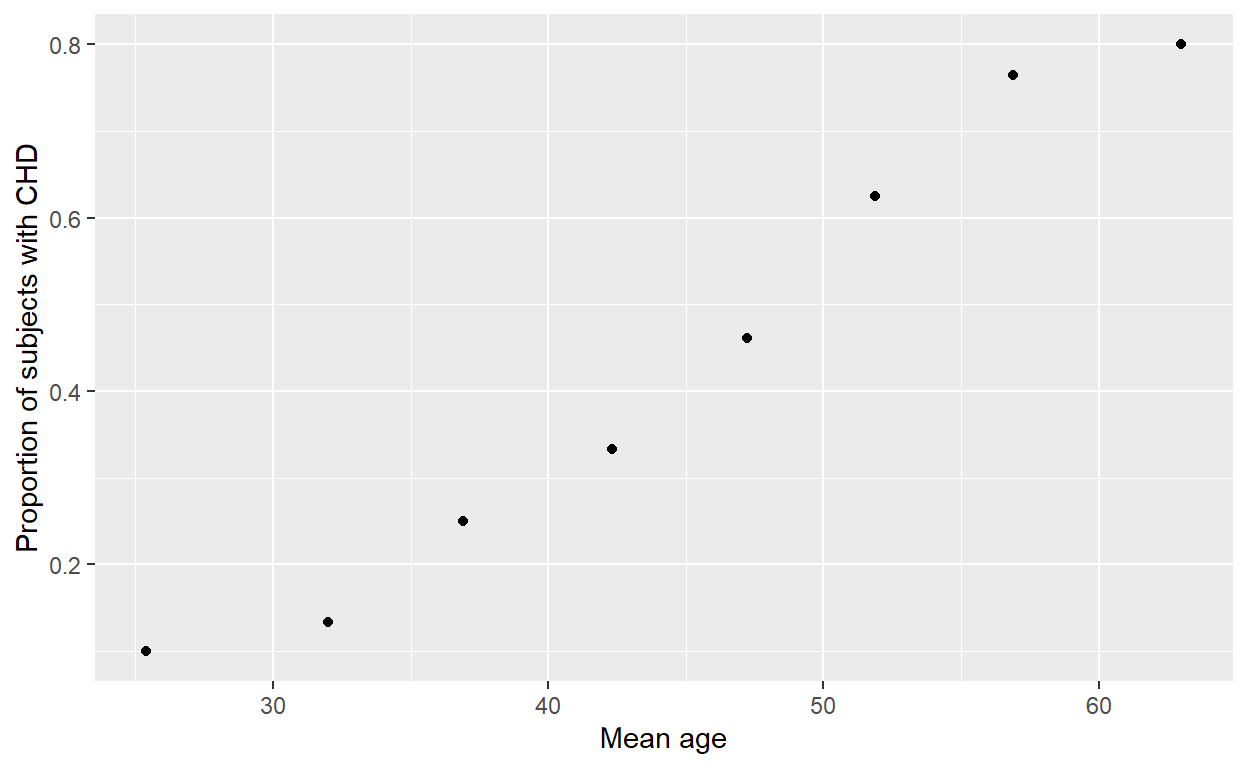
Fit the basic logistic regression model with chd ~ age. What is the odds ratio for a 1 year increase in age?
Plot Pregibon’s \(\Delta\hat\beta_i\) against the fitted values for this model. Are any points particularly influential?
chd_pregibon <- function(model) {
Y <- tapply(model$y, list(model$model$age), sum)
M <- tapply(model$y, list(model$model$age), length)
vY <- Y[as.character(model$model$age)]
vM <- M[as.character(model$model$age)]
pr <- (vY - vM*model$fitted.values)/sqrt(vM*model$fitted.values*(1-model$fitted.values))
V <- vcov(model)
X <- cbind(rep(1, 100), model$model$age)
uhat <- diag(X %*% V %*% t(X))
hat <- uhat*vM*model$fitted.values*(1-model$fitted.values)
db <- (pr^2*hat)/(1-hat)^2
}
db <- chd_pregibon(chd_model)
plot(fitted(chd_model), db, type = 'h')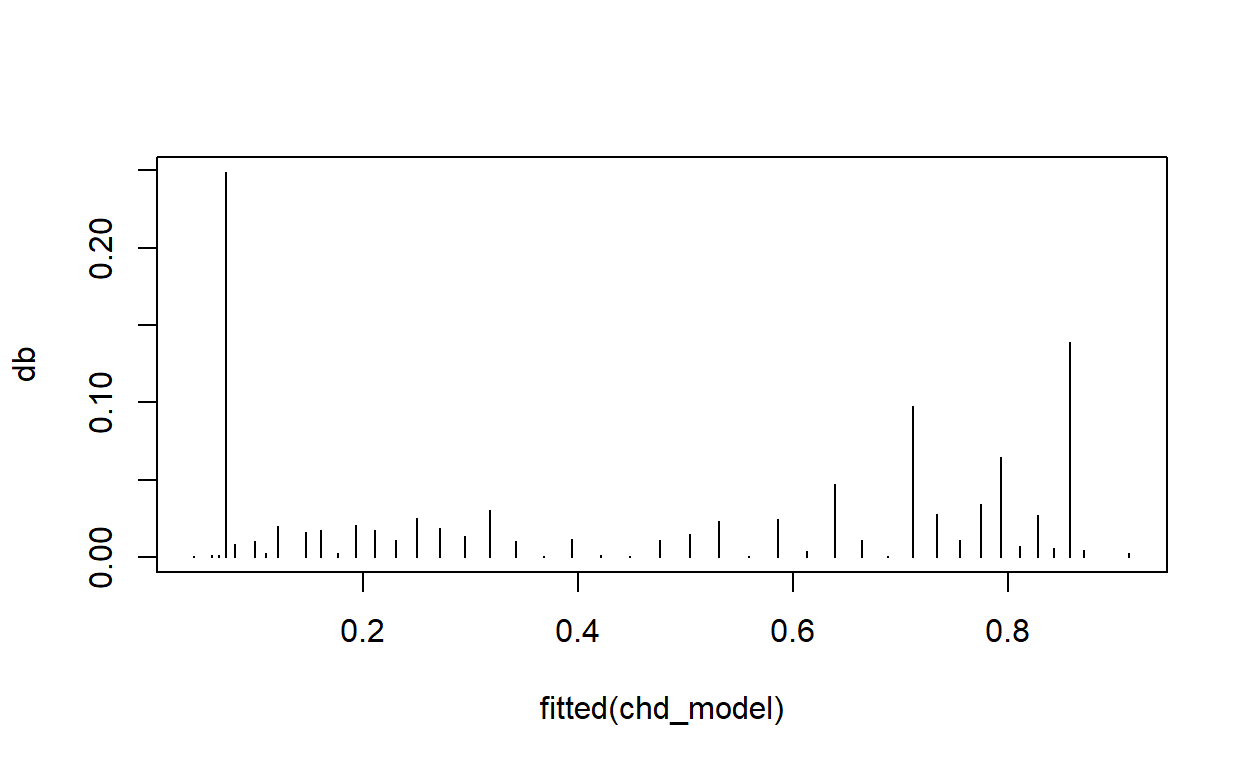
# plot(chd_model, which = 4) age
1.130329 